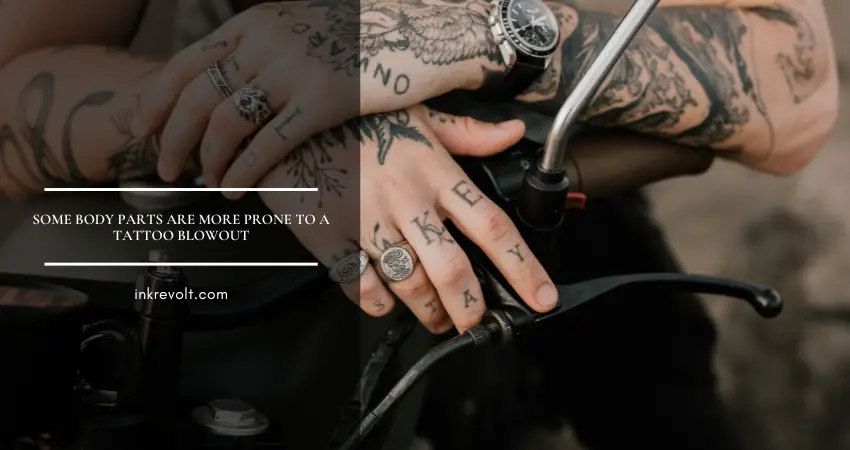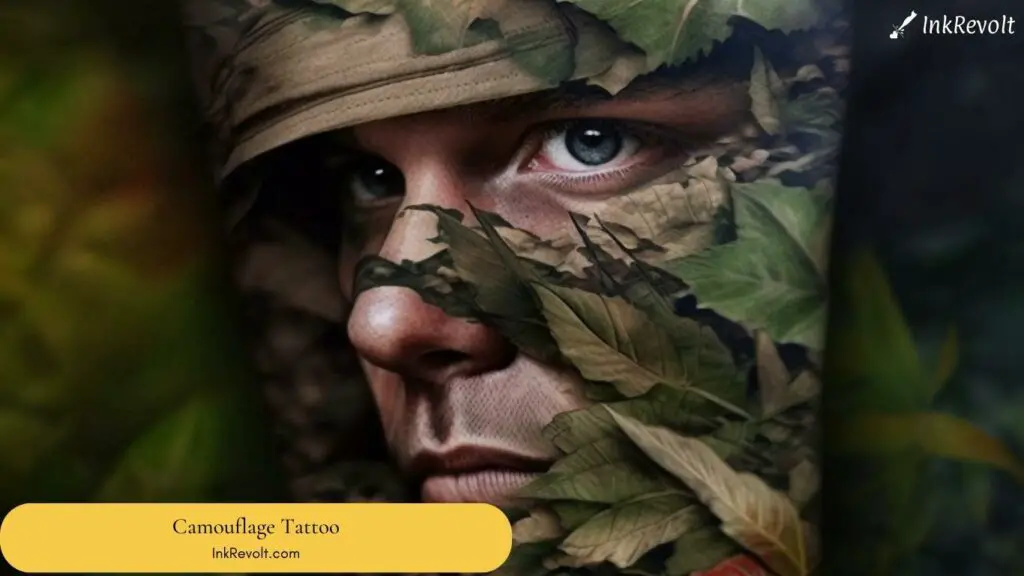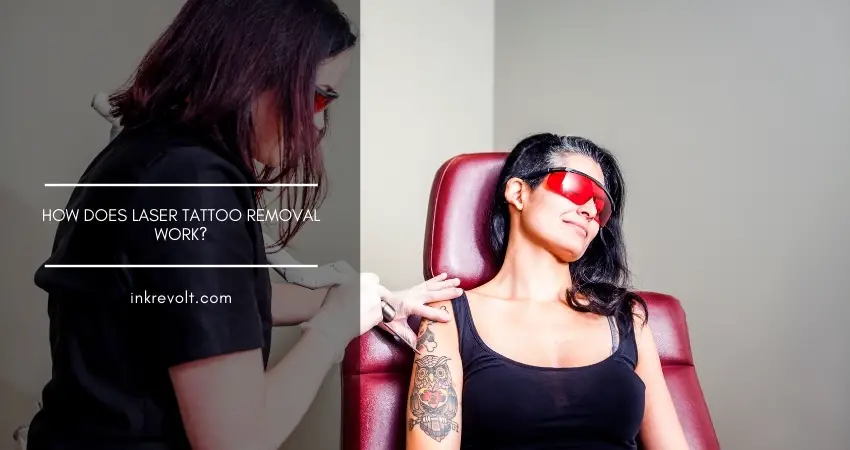What Causes The Tattoo Ink To Spread?
If you have just got a new and fresh tattoo, you may notice that the ink is spreading over the tattoo lines in the first few days. If that happens, do not start panicking. It is a tattoo blowout. Although it is not serious, it can be harmful to your health, not to mention impacting your tattoo’s shape and look.
What causes the tattoo ink to spread over a tattoo is when your tattoo artist inserts the needles at wrong angles or too deep into your skin, or if you have it done on a body part where the skin is very thin, or if you tattooist stretches or pulls at your skin a lot.
But there are ways to fix and even prevent a tattoo blowout. Read the entire article to find them out.
How Does Spreading Tattoo Ink Look?
You will know that your tattoo is blowing out within some days of having a newly made tattoo. Some people have mild ones, but some face them at an extreme level.
However, in every case, the blowouts blur your tattoo lines, and the ink moves beyond their edges. You will see that the tattoo ink has started bleeding outward and giving the tattoo a blotched look.

What Causes The Tattoo Ink To Spread?
1. When The Tattoo Artist Inserts The Needles At Wrong Angles Or Too Deep
It is the most typical reason for a tattoo blowout. If your tattooist inserts the needles too deep into your skin, it will get the ink dispersed into the skin layer the needles should not have touched. It is also quite painful for the person getting the tattoo.
The tattoo artist might also use the needles at some wrong angle, which will also cause the ink dispersion into the neighboring tissues, creating a tattoo blowout effect.
Although experienced tattoo artists usually can decrease the risks of causing blowouts, it is not always that easy to avoid in particular areas of one’s skin. So it is not always right to think that the mistake is on their part. Sometimes it can happen even to highly experienced artists.
But again, if the artist is not so experienced, the likeliness of them making a mistake, potentially overworking the area, and causing a blowout is higher.
2. When The Skin Is Very Thin
There are areas in your body containing extremely thin skin layers. Drawing on those areas is a delicate job. So the chance of a tattoo blowout occurring there is definitely higher than somewhere with thick skin layers.
The reason here is that the needles will protrude into the thin skin and reach the lower layers easily, potentially causing a blowout.
Areas more vulnerable to tattoo blowouts are the tops of your hands and feet, toes, fingers, wrists, and ankles.
Tattoos also tend to have more proneness to blowouts when tattooists add them onto your joints, for example – inside your elbow or behind your knee. However, that is pretty uncommon. Again, an experienced and professional tattoo artist will not puncture deep into the delicate areas. But I cannot say there are zero possibilities of that.
3. When The Tattoo Artist Stretches Or Pulls At Your Skin A Lot
Tattoo Artists have to pull and tighten your skin a little to make sure they inserted the tattoo ink at the correct location and the ink distribution is even and flat.
But if your tattoo artist pulls it too tightly, and that too on a thin and delicate area, it will cause the needles to go at odd angles because of the skin stretching. That, in turn, will potentially result in making the ink spread.
4. Which Body Parts Are More Prone To A Tattoo Blowout?
Some body parts are more prone to a tattoo blowout than others because of their movements or skin thinness.

For instance, your fingers have more chances to experience a tattoo blowout because their skin is not thick at all. That makes it easier for your tattoo artist to accidentally make deep needle protrusion and hurt the lower layer tissues. You see, this is where you cannot hold your tattoo artist responsible for your blowout. It just happens sometimes.
Your wrists are also susceptible because they move frequently. If you move your joints too much after just having a tattoo, the movements will pressurize the ink and push it out.
Luckily, most tattoos made in these body parts usually turn out just fine. So you should choose a great tattooist to minimize the risks.
5. Factors That Can Affect Ink Spread During Healing Process
The healing process is critical to the outcome of a tattoo. Proper aftercare can minimize ink spread, while improper care can exacerbate it. Some of the factors that can affect ink spread during the healing process include:
- Scabbing: Excessive scabbing can cause the ink to pull away from the skin, resulting in faded colors and blurred lines.
- Peeling: Peeling skin can cause the ink to flake off, resulting in gaps in the design and faded colors.
- Moisturizing: Proper moisturizing can help keep the skin hydrated, preventing excessive scabbing and peeling.
Risks associated with tattoo ink spread
When tattoo ink spreads, it can result in a variety of unwanted outcomes, including:
- Blurring of tattoo lines: When ink spreads, it can cause the lines of the tattoo to become blurred and indistinct.
- Fading of tattoo colors: Excessive ink spread can cause the colors of the tattoo to fade, making it look dull and unappealing.
- Creation of unintended designs: When ink spreads, it can cause the design to look different from what was intended, resulting in an unsatisfactory outcome.
- Health risks: Ink spread can also pose health risks, including the risk of infection, allergic reactions, and bloodborne diseases.
Techniques to minimize tattoo ink spread
Fortunately, there are several techniques that tattoo artists can use to minimize ink spread and achieve a high-quality tattoo. These include:
1. Proper needle depth
Tattoo artists should ensure that they are using the appropriate needle depth for the skin they are working on. If the needle penetrates too deeply, it can cause the ink to spread and result in blurred lines and faded colors.
2. Optimal tattooing speed
Tattoo artists should work at a steady pace to ensure even ink distribution. Fast tattooing can cause the ink to spread, while slow tattooing can result in uneven ink distribution.
3. Correct needle angle
Tattoo artists should ensure that the needle is inserted at the correct angle to achieve the desired effect. The angle can affect how deeply the needle penetrates the skin, which can impact ink spread.
4. Aftercare instructions
Proper aftercare is critical to minimizing ink spread and achieving a high-quality tattoo. Tattoo artists should provide their clients with aftercare instructions, including:
- Proper cleaning: Clients should clean their tattoo regularly with mild soap and warm water to prevent infection and reduce scabbing.
- Moisturizing: Clients should moisturize their tattoo regularly with a fragrance-free lotion to prevent excessive scabbing and peeling.
- Avoiding direct sunlight: Clients should avoid exposing their tattoo to direct sunlight or tanning beds for at least four weeks after getting inked.
How Can I Fix A Tattoo Blowout?
You can follow either of the three ways presented below to fix it.
1. A Camouflage Tattoo
It is the least costly way to fix a tattoo blowout. You can camouflage it with further tattooing. Depending on your tattoo size and the blowout condition, a cover-up will cost you from $90 to $300.

If you see the blowout within a week after getting the tattoo, you will need to wait around two months to let your tattoo heal before attempting to get a cover-up. During this time, it becomes even more important for you to take care of your tattoo for an ideal healing result.
The plus point of a well-made cover-up tattoo is that it lets you keep your tattoo’s appearance while reducing the blowout portion.
If the condition of your blowout becomes severe, you may have to get a larger or darker tattoo than your original one. It could look considerably different from how you wanted it.
It requires skills and expertise to make a blowout cover-up. This time, choose a highly experienced tattooist to ensure you will not have another tattoo blowout. A good tattooist also possesses the creativity required to maximize your tattoo appearance.
2. Laser Therapy
Laser therapy is also effective in reducing the blowout appearance. The Q-switched lasers use energy waves to your skin, and ink particles absorb them. The energy then diffuses them further to make them less noticeable.
This method gives you back the tattoo that you originally intended, vanishing little or no traces of the blowout. After the treatment, maintain your tattoo as per the instructions given by your healthcare provider. Keep it from sun exposure to prevent it from fading.

Although laser therapy does not always provide the best result for everyone, most people have found it fruitful. It will require you to take four to more sessions to fade the blowout to a great extent. How many sessions you will have to go through varies with the blowout extent and how your body reacts to the therapy.
On another note, the method is costlier than the previous one. The total expense calculation is based on your tattoo color, age, and size. And take notes that your insurance company is highly unlikely to pay for it since it falls under the cosmetic surgery procedure.
3. Tattoo Removal Surgery
This one is an invasive way to deal with a tattoo blowout. To get rid of a blowout, you have to say goodbye to your tattoo as well. During excision or surgery, the surgeon cuts the tattooed skin off and sews the remaining skin with each other.
It is the one and only method to remove a blowout wholly. Just like laser therapy, insurance also does not help you with the cost here.
Other considerations regarding tattoo removal surgery cause scarring and require recovery time. The smaller your removed tattoo, the fewer scars you will have.
How Can I Prevent A Tattoo Blowout?
You cannot consider tattoo blowouts as tattooing complications. They are more like mistakes happening because of carelessness, insufficient experience. Or it can be as simple as the fact you were unlucky. Notwithstanding that, you can do a thing or two to reduce the risks of having a blowout.
1. Considering The Tattoo Placement
Experts say that if you choose to have a tattoo inside your arm or somewhere with thinner skin, you will increase the chance of getting a blowout. It also hurts a lot to get a tattoo in these areas. So, if you do not want to keep things at the chance, you should consider the placement of your tattoo.
Women are usually more prone to blowouts than men since their skin is thinner. So they may choose an area with thick skin to get a tattoo, maybe somewhere on their legs.
2. Choosing The Right Tattoo Artist
While it is always possible that any artist might make these mistakes, it will minimize your risks significantly if you choose a tattooist with more experience and skill. You can look for recommendations from your family, friends, and relatives.
Before getting a tattoo, check that your tattoo artist has a license, and their tattoo shop is clean and maintains proper health standards.
When Do I Need To Consult A Professional?
When you notice that your tattoo started blurring after several days of getting it, you will know that it is a tattoo blowout. What you have to do first is notify your tattoo artist right away.
If your tattoo artist offers to make a cover-up, consider other options before agreeing to do that. You might want to consult another tattoo artist for camouflage if you are dubious about your tattoo artist’s skill. Or maybe you would prefer laser therapy, thinking you want to keep your tattoo and reduce the blowout appearance.
Once you determine what to do next, wait until the healing period is over. Then contact a well-reputed tattooist with experience if you choose to have a cover-up. If you want to try surgical options or laser treatment, see a dermatologist.
Final Words
A tattoo blowout is an unlucky and undesirable repercussion for some individuals who have just had their tattoos. While you cannot prevent it wholly, you can initiate some measures to lower your chances. Now you know what causes the tattoo ink to spread, so remember the precautions that can help you avoid a blowout. Despite that, if you get one, follow the discussed steps to handle it.
Finally, be very sure to get a professional tattooist. It is the first step to bring your possibility to get a tattoo blowout down to the lowest.
I hope the information was helpful. Thanks for reading.
